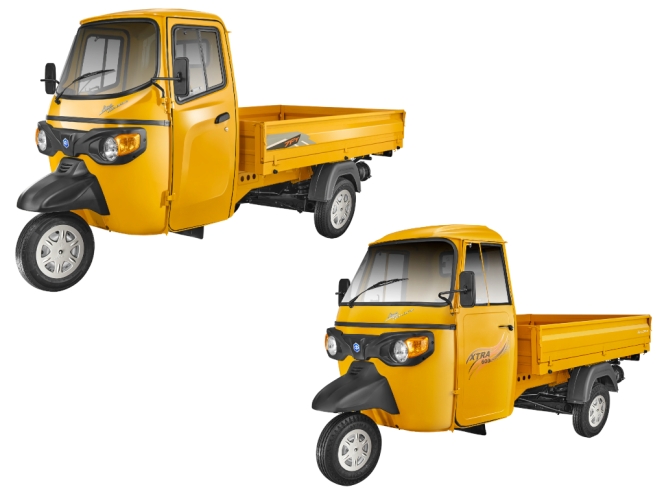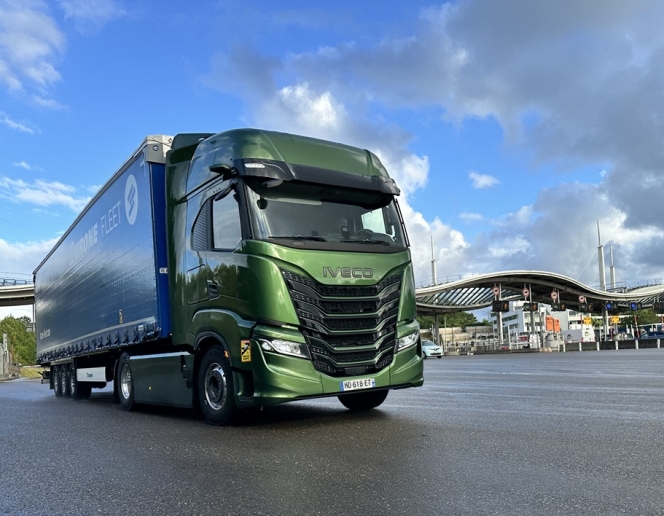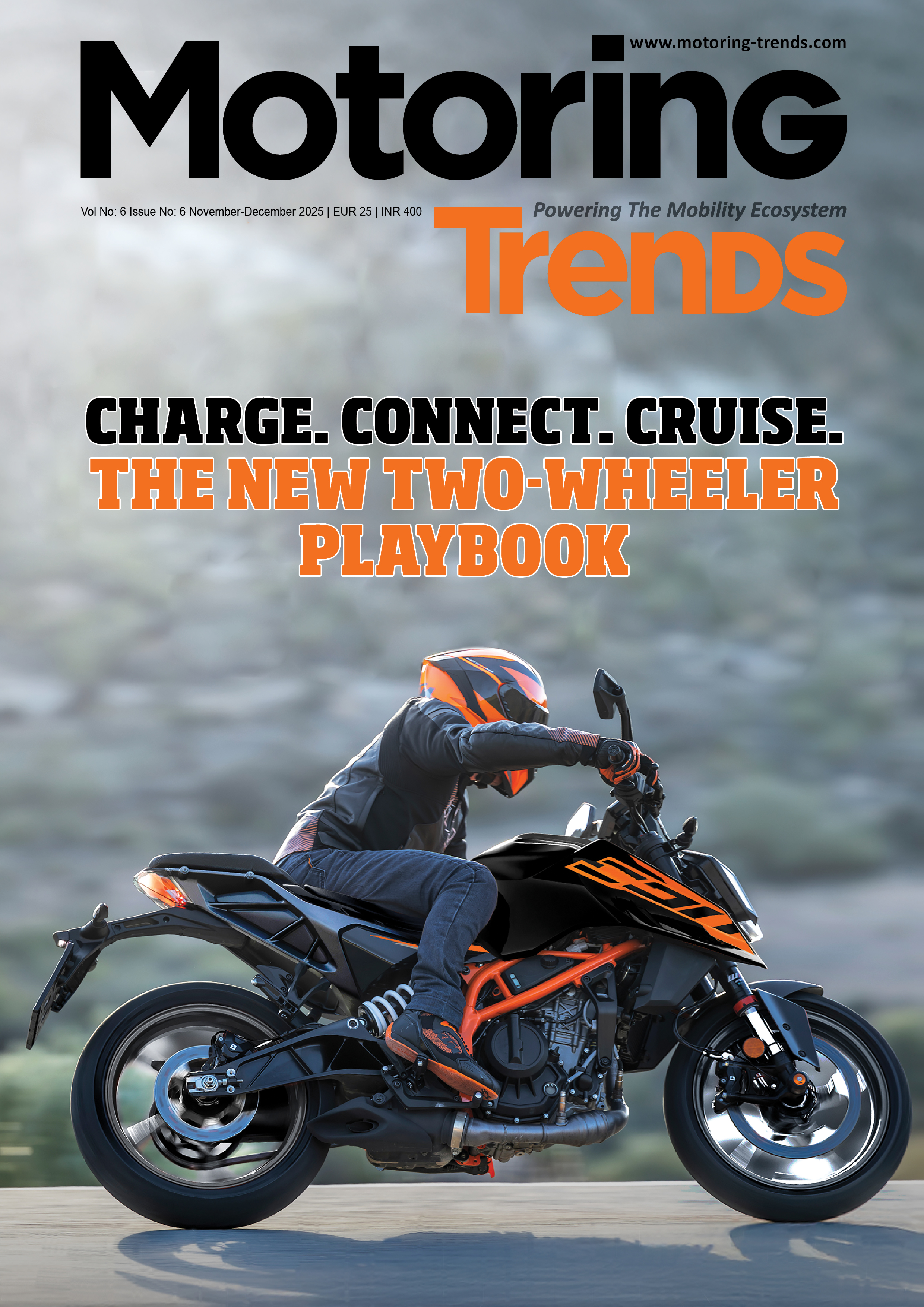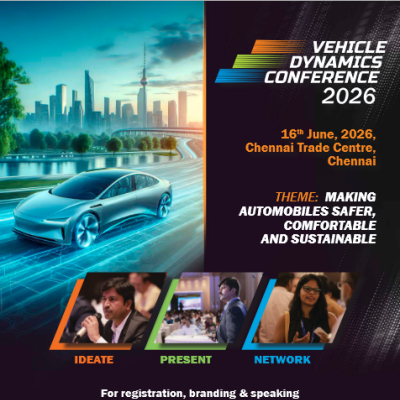Commercial Vehicles: Rising to the Occasion
- By Juili Eklahare
- August 12, 2022

Huge changes are finding their way into the commercial vehicles market. It is not just the CVs that are changing but even the drivers driving them, who are being inclined to learn recent technologies associated with CVs. We see this transformation happening at a rapid pace. Paritosh Gupta, Sr Analyst, Medium and Heavy Commercial Vehicle Forecasting, S&P Global Mobility (formerly IHS Markit Automotive), throws light on the electric impact on CVs, making commercial vehicle drivers more tech-savvy and how collaboration can help the industry turn around.
The commercial vehicles (CVs) market has incredible potential still unexplored. In fact, industry experts cite that the demand for CVs will go up and is heading for immense growth. And why not, especially when the industry has great opportunities for modernisation, and connectivity and data being a substantial focus. And, of course, we cannot forget the biggest trend, not just in CVs but the overall automotive industry, that is electric vehicles (EVs).
Focusing on medium and heavy commercial vehicles (that are about six tonnes in weight), which usually includes all the trucks and buses, Paritosh Gupta, Sr Analyst, Medium and Heavy Commercial Vehicle Forecasting, S&P Global Mobility, too, explains that in terms of MHCVs, the biggest trend right now is the great amount of electrification going on in the bus sector, which is primarily led by the demand from the government side. “There are a lot of tenders by CESL and EESL, who have announced that they are planning to onboard around 50,000 electric buses in the next five to six years, something we are looking forward to,” he informs and goes on, “Besides, there is a lot of demand for tipper trucks due to the increased construction activities going on across the country – especially the highway and infrastructure projects that the government has undertaken.”
Gupta further mentions that there is a lot of pent-up demand in the market, which the industry really sees driving the market forward – that is expecting anywhere between 18-22 percent of growth.
E-pickup trucks
Speaking of electrification, it is well known that most major truck manufacturers have planned electric pickup trucks. We even find industrial giants like Tesla and Toyota venturing into e-pickup trucks. In such a case, the most popular pickup truck – when it comes to electric pickup trucks – is the Rivian, Gupta tells us. “India, however, does not have electric pickup trucks as of now, and many of them are in the US. Moreover, these pickup trucks are not pickup trucks in the commercial vehicle sense. Plus, these trucks happen to be expensive in comparison to conventional pickup trucks, especially the ones used in the commercial space,” he says.
Gupta further opines that there might be a few launches of electric pickup trucks here and there, but it will take a while for them to become common.
Last-mile deliveries
We also see that last-mile deliveries have been transitioning to EVs from internal combustion engine (ICE) vehicles lately in India. Sharing more on this, Gupta tells us, “In terms of last-mile deliveries transitioning to EVs, it is still a small percentage of vehicles. Even metro cities like Mumbai or Delhi will not have a sudden surge of vehicles transitioning to EVs, because EVs have many restrictions even today. Yes, it is happening but at a gradual pace, and it will not happen overnight.”
However, this transition is bound to happen in any case, especially with the targets the government is making; for example, the CAFE norms, he adds. “So, every major manufacturer will have to have some sort of EV in their portfolio to adhere to those norms. And if they need to continue to sell vehicles that are diesel- or gasoline-powered, in higher numbers, then they need to have something to offset those emissions,” says Gupta.
“Small commercial vehicles – which operate in last-mile connectivity – are the low-hanging fruits here, because they do not need that big a range; these vehicles ply 10 to 12 to 14 hours a day and have an extremely limited range requirement. They do not travel 600 or 700 kilometers a day and can go into their hubs at night and get charged,” Gupta further shares.
Delhi government's move to curb pollution
The whole EV scenario, whether private vehicles or CVs, comes with the objective to head towards a better environment and to control pollution. The Delhi government, too, has restricted the entry of heavy and medium commercial vehicles from October 2022 to February 2023 to limit pollution – a move that has been opposed by truckers and traders.
“This move has come about in the past as well, on immediate notice. Only this time, it has come earlier,” Gupta points out and goes on, “While the truckers and related associations are opposing this move, they also need to consider the fact that CNG-powered vehicles have not been stopped and are allowed to enter the city. Furthermore, the transport hubs, which are already present at the Delhi border areas, will come in handy. And lastly, last-mile connectivity in Delhi is already CNG-powered; therefore, that should not be a
problem."
“Hence, the only factor that we need to look after is the movement of heavy trucks within the city, which is not much and already takes place through CNG-powered trucks,” Gupta puts across and adds, “So while it won’t affect the overall movement of the cargo, it certainly will raise logistics-related costs.”
The logistics
That being so, the growing logistics demand of businesses in India needs to be addressed efficiently, particularly with last-mile logistics growing tremendously. But how?
“In terms of long-term hauling, artificial intelligence (AI) and machine learning (ML) definitely have a role to play here,” Gupta asserts and continues, “Secondly, the improvement of roads, infrastructure and driver assistance systems will play a significant role as well. In fact, digitalisation and connected tech will play a particularly good role in improving this sector’s efficiency and the TCO for the fleet owners. If we look at the upcoming transport operators, we will see that they are now using AI and ML to route maps for a particular truck. Therefore, one thing that is for sure is that technology is going to play a significant role here.”
Making drivers more tech-savvy
Turning his attention further to another element – the drivers – Gupta elucidates, “The drivers in India lack the understanding of the modern systems that are present in the vehicle. In fact, when I was recently at a conference, I was discussing the uptake of connected tech in terms of trucks and buses. So, a gentleman over there shared that we can put whatever we want in a truck (and it’s not like the fleet owners are not willing to pay for it; they will pay for it because they know the benefit of these technologies). However, the problem is that the driver is not going to use the technology to benefit the fleet owner.”
“Therefore, we need to educate the drivers towards these technologies and how they can be beneficial, not just to the fleet owners but to the drivers themselves,” Gupta explains.
Autonomous trucks – what is it going to take?
While educating the drivers about innovative technologies is important, we dream of driverless vehicles, aka autonomous vehicles, too. Sharing his views on this, Gupta cites, “I do not see autonomous trucks in India at least in this decade or till early next decade. There are a few reasons behind this. Firstly, autonomous trucks need the infrastructure and roads to be adherent to standards so that the right calculations are being referenced, and they can ply on the road.”
“Secondly, it’s the legal landscape,” he goes on, “Even today in the US, where several autonomous trucks are being evaluated, the legal framework has still not been set up. So, in case of an accident, who should be held responsible? A human driving the car? The autonomous truck? Or the software providers? Hence, there is a lot of ambiguity around the legal landscape, which is the biggest problem we have right now when it comes to autonomous trucks making a place in the market."
“But what’s certain is that autonomous trucks will change the face of logistics, but only once they become a mass market reality,” Gupta further adds, “So while we have technologies that are being worked upon in order to make this a reality (with a legal framework in place), what needs to be seen is if having the autonomous truck on the roads is going to be viable and a mass market solution. Because in CVs, it’s not the customer preference that drives the buying decision – it’s the total cost of ownership and the profitability of that particular vehicle that drives that decision at the end of the day.”
Collaboration in the CV space
Another factor that can drive the future of CVs and autonomous logistics is collaboration. And collaboration is already happening in the space of CVs.
“In fact, conventional OEMs are either acquiring or investing in new-age start-ups to improve their efficiencies and expertise in the modern technologies in the market,” Gupta shares and goes on, “Therefore, collaborations are definitely the key to solving the problems of the future.”
“In addition, we also see that collaborations are going to happen between OEMs and software providers, OEMs and the government and trade bodies and so on," he further tells us and says, “Thus, all these collaborations are needed to produce actual and viable solutions that are sustainable over the long term. The most prominent collaboration, according to me, will be OEMs investing in start-ups on the line of EVs. Under this, we could also count infotainment, driver systems etc.”
The role of OEMs in CVs
In truth, OEMs, too, can play a significant part in transforming the CV sector. Gupta highlights that the biggest way in which OEMs can contribute to the CV sector right now is by improving the connectivity of their vehicles and including a lot of connected tech. “This way, fleet owners have access to their vehicles all the time,” he states and adds, “Plus, there is also the data analytics part – we see a lot of data coming from the trucks and logistics space, which we can analyse. This will help to work on improving the efficiency and finding the bottlenecks where the truck and logistics space is facing problems.”
A turning point
The Indian CV sector, in spite of all the hurdles it has faced – from the Covid waves to the chip shortage – has performed very well. Identifying problems and removing them needs a lot of data, for which we need connected tech for our CVs. EVs are the biggest automotive trend right now, and we are glad to see CVs inclined towards that trend.
Therefore, bringing in not just the latest technologies but everything we can think of that can help India’s CV sector flourish, truly will. That means collaboration, digitalisation, the OEMs doing their bit and even the legal aspects of it. With agility and the right innovation, the Indian CV industry is certainly heading towards a turning point.
Force Motors' Domestic Sales Grows 59% In November
- By MT Bureau
- December 01, 2025

Force Motors, India's largest van maker, reported a strong 59 percent YoY growth in domestic wholesale for November 2025, as compared to last year.
The company attributed the surge in sales to the rapid scaling of the Urbania and Trax platforms, both of which now contribute a higher share to overall volumes. Trax, in particular, has benefited from the recent GST rationalisation on rural mobility categories, which has improved affordability and accelerated replacement demand across rural and semi-urban markets.
Traveller, the company’s people-mobility platform, continues to anchor volumes with consistency and year-to-date growth, while the Monobus recorded sustained traction through increased institutional and state transport requirements.
For April to November 2025, Force Motors registered a 23 percent year-to-date growth, driven by adoption of new-generation platforms and improved demand across core customer segments.
Prasan Firodia, Managing Director, Force Motors, said, “We are pleased with the sustainable growth in our domestic sales, which reflects the strong customer confidence in our range of reliable and robust vehicles. While domestic wholesales grew by 59 percent in November 2025, overall volumes were moderated by expected fluctuations in export dispatches, which typically vary based on shipment cycles across international markets. Despite this, total wholesales still registered a strong 53 percent YoY increase, underscoring the company’s resilient growth trajectory”.
The company continues to see rising demand across key sectors including rural transportation, staff carriers and goods movement. Force Motors remains committed to innovation and customer satisfaction, ensuring performance and low total cost of ownership.
Montra Electric Launches E-27 Tractor At INR 1.07 Million
- By MT Bureau
- November 27, 2025

Montra Electric, the clean mobility brand of the Murugappa Group, has marked its entry into the northern markets with the Montra Electric E-27 tractor at the EIMA Agrimach India 2025 exhibition.
The E-27 is stated to be India’s first ARAI-certified electric tractor and delivers 27 HP equivalent power and 90 Nm torque through a high-efficiency PMSM motor, enabling performance in plowing, tilling, spraying and haulage. The e-tractor comes with 2WD and 4WD drivetrain options.
The E-27 is now available for purchase in 17 dealerships across 10 states, with prices starting from INR 1.07 million (ex-showroom).
Its 22.37 kWh LFP prismatic-cell battery pack offers a runtime of approximately 4.5 hours with a charging time of 2.15 hours. The E-27 is ARAI certified, confirming its compliance with national standards for safety, reliability and performance.
The tractor features an 8F + 2R side-shift transmission, a dual-speed PTO (540 and 1000 rpm) and a 720 kg hydraulic lifting capacity. Economically, the E-27 reduces operating costs by up to 70 percent due to no diesel consumption and lower maintenance requirements, resulting in lifetime savings nearing INR one million compared to conventional diesel models. The quiet operation and reduced vibration improve operator comfort.
Harish Prasad, CEO, Montra Electric Tractors, said, “The expansion into the northern markets with our Montra Electric E-27 tractor is a pivotal milestone for us and a major step in India’s clean-mobility and agricultural transformation. Agriculture is the largest consumer of tractors, which makes electrification essential for achieving meaningful sustainability at scale. The E-27 reflects our broader vision of building clean, accessible, and future-ready mobility solutions. By bringing zero-emission technology to India’s farmlands, we are aligning our mission of sustainable mobility with the nation’s long-term environmental and economic priorities. Farmers can now embrace cutting-edge technology without compromising productivity, while substantially reducing their total cost of ownership.”
Piaggio Launches Ape Xtra Bada 700 And Ape Xtra 600 Diesel Cargo Three-Wheelers
- By MT Bureau
- November 20, 2025

Piaggio Vehicles, a subsidiary of the Piaggio Group, has launched two new diesel cargo three-wheelers in India – the Ape Xtra Bada 700 and the Ape Xtra 600 priced at INR 345,000 and INR 288,000 (ex-showroom Maharashtra), respectively.
The new three-wheelers are designed to strengthen the company’s position in the last-mile cargo sector and compete with entry-level four-wheel cargo small commercial vehicles (SCVs).
The Ape Xtra Bada 700 introduces features intended to set new industry standards in the three-wheeler cargo category. It features the company's 700 DI diesel engine, providing pulling power and enhanced torque. The vehicle debuts India's first 7 feet cargo deck, allowing for larger and longer loads. It offers a segment-best 750 kg payload capacity, the largest in any three-wheeler cargo vehicle. Other features include a new platform, a digital cluster, 12-inch radial tyres, a new cab and an industry warranty of five years.
The new Ape Xtra 600 features Piaggio's newly developed 600 DI diesel engine, offering improved mileage, better gradeability, and enhanced load-carrying performance. The vehicle is positioned as a reliable and efficient option at an accessible price point.
Diego Graffi, Chairman & Managing Director, Piaggio Vehicles, said, “At Piaggio India, we have always believed in pushing the boundaries of innovation in the last-mile mobility segment. The Ape Xtra Bada 700 is a landmark product that disrupts the cargo 3-wheeler category with industry-first features in engine capacity, deck size and payload. It is designed to empower customers with more productivity and superior earnings. Alongside, the Ape Xtra 600 continues our commitment to delivering efficient, high-value solutions. With these new diesel cargo products, we strengthen our Ape legacy and reiterate our focus on customer-centric engineering.”
Amit Sagar, Executive Vice-President, CV Domestic Business & Retail Finance, Piaggio Vehicles, added, “Cargo mobility demands are changing rapidly, with customers expecting higher power, higher payload, better comfort, and stronger performance. The Ape Xtra Bada 700 addresses all these needs with a fresh, powerful new platform and several industry-firsts that directly enhance profitability for customers. It provides the most efficient, economical, and affordable option for a Cargo 3W and provides a compelling alternate to the four-wheeler cargo vehicles with an advantageous Opeco and TCO. The Ape Xtra 600 also brings improved capabilities to our strong diesel cargo portfolio. We are confident that these products will further strengthen our leadership in the cargo three-wheeler market.”
IVECO S-Way CNG Truck Achieves 1,000km Range On Single Refill
- By MT Bureau
- November 20, 2025

IVECO, a manufacturer in alternative propulsion, has demonstrated the endurance of its gas-powered heavy vehicles with the IVECO S-Way CNG truck travelling over 1,000 kilometres on one refill of compressed natural gas (CNG).
The test was carried out under real-world conditions by French journalists Fabien Calvet and Loic Fieux, driving between the Belgian and Spanish borders. The tractor unit towed a loaded curtain-sided semi-trailer with a gross combination weight of 30 tonnes, confirming the S-Way CNG’s efficiency and viability for daily operations. The result showed an average consumption of below 21 kg / 100 km over the distance, combined with quick refuelling.
The truck's gas engine is said to have delivered smooth, responsive and quiet performance, with handling comparable to a diesel model. The journalists noted the vehicle's high-performance engine brake and intarder hydraulic retarder offered strong braking, while the full air suspension enhanced driving comfort.
The model tested uses the xCursor 13 engine by FPT Industrial, producing 500 hp and 2,200 Nm of torque. This engine is designed to meet future Euro VII emissions standards and is paired with a second-generation ZF TraXon 12-speed automated gearbox.
The vehicle was equipped with new 620-litre tanks, providing a total capacity of 1,240 litres equivalent to at least 190 kg of CNG. This capacity represents an 18 percent increase over the previous generation.
IVECO utilised multiple systems to maximise fuel efficiency:
- Predictive GPS systems worked to recover kinetic energy on downhill sections and adjust engine speed ahead of climbs.
- Intelligent energy management features, including a controlled alternator and a dis-engageable air compressor, ensure energy is only consumed when necessary.
- Aerodynamic improvements such as deflectors, side fairings and mirror-cams help to reduce drag.
The gas-powered trucks offer a transport solution that is both sustainable and cost-effective, supported by an established European refuelling network. Operators can utilise the approximately 4,300 bioLNG and 800 BioCNG stations currently in operation.
When running on biomethane, which is produced from organic waste, the trucks can reduce carbon dioxide (CO2) emissions by an average of 95 percent, alongside lower fine particle and nitrogen oxide emissions compared to diesel. The European gas refuelling network is set to expand further, with 50 new stations scheduled to open in 2026.






Comments (0)
ADD COMMENT